Energy-Efficient Swarming Flight Formation Transitions Using the Improved Fair Hungarian Algorithm
Abstract
1. Introduction
- (1)
- To increase the operating time for drone shows, the Fair Hungarian algorithm is proposed to achieve fair energy consumption. The proposed algorithm equalizes the energy demand of the drones by minimizing the maximum movement distance between drones in a swarming flight scenario.
- (2)
- The drone show technology stacked on the veil is discussed. In this paper, methods to realize efficient communication and reliable position estimation for a swarming flight system are discussed. The communication mechanism can operate regardless of the number of drones. The position estimation based on the real time kinematic global positioning system (RTK-GPS) can switch mode smoothly when the RTK-GPS is not used.
- (3)
- The algorithm and system are verified through implementation in drone shows involving 100 drones with numerical experiments.
2. System Architecture
2.1. Overall Architecture
2.2. Efficient Communication
2.3. Position Estimation
3. Scenario Generation
3.1. Problem Statement
3.2. Hungarian Algorithm
| Algorithm 1. Pseudocode for the Hungarian algorithm Function Hungarian-Algorithm (). |
| % initial vertex feasible labeling |
| while |
| % find the maximum matching |
| do |
| while |
| % update the feasible vertex labeling |
| done |
3.3. Proposed Algorithm
| Algorithm 2. Pseudocode for the proposed Fair Hungarian algorithm |
| = Hungarian-Algorithm () |
| = Layer () |
3.4. Numerical Example
4. Results of a Swarming Flight Experiment
4.1. Implementation
4.1.1. Drones
4.1.2. Ground Control System (GCS)
4.2. Experiment
4.3. Experimental Analysis
5. Conclusions
Author Contributions
Funding
Institutional Review Board Statement
Informed Consent Statement
Data Availability Statement
Conflicts of Interest
References
- Kuru, K.; Ansell, D.; Khan, W.; Yetgin, H. Analysis and Optimization of Unmanned Aerial Vehicle Swarms in Logistics: An Intelligent Delivery Platform. IEEE Access 2019, 7, 15804–15831. [Google Scholar] [CrossRef]
- Kshetri, N.; Rojas-Torres, D. The 2018 Winter Olympics: A Showcase of Technological Advancement. IT Prof. 2018, 20, 19–25. [Google Scholar] [CrossRef]
- Bennet, D.J.; MacInnes, C.R.; Suzuki, M.; Uchiyama, K. Autonomous Three-Dimensional Formation Flight for a Swarm of Unmanned Aerial Vehicles. J. Guid. Control Dyn. 2011, 34, 1899–1908. [Google Scholar] [CrossRef][Green Version]
- Guo, H.; Pang, J.; Han, L.; Shan, Z. Flight Data Visualization for Simulation & Evaluation: A General Framework. In Proceedings of the 2012 Fifth International Symposium on Computational Intelligence and Design, Hangzhou, China, 28–29 October 2012; pp. 497–502. [Google Scholar]
- Huo, C.; Lai, T.; Sun, T. The Preliminary Study on Multi-Swarm Sharing Particle Swarm Optimization: Applied to UAV Path Planning Problem. In Proceedings of the 2011 IEEE Congress of Evolutionary Computation, New Orleans, LA, USA, 5–8 June 2011; pp. 1770–1776. [Google Scholar]
- Cho, D.-H.; Moon, S.T.; Jang, J.T.; Rew, D.-Y. Collision Avoidance Maneuver Design for the Multiple Indoor UAV by Using AR. Drone. J. Korean Soc. Aeronaut. Space Sci. 2014, 42, 752–761. [Google Scholar] [CrossRef]
- Mellinger, D.; Shomin, M.; Michael, N.; Kumar, V. Cooperative Grasping and Transport Using Multiple Quadrotors. In Distributed Autonomous Robotic Systems: The 10th International Symposium; Martinoli, A., Mondada, F., Correll, N., Mermoud, G., Egerstedt, M., Hsieh, M.A., Parker, L.E., Støy, K., Eds.; Springer: Berlin/Heidelberg, Germany, 2013; pp. 545–558. ISBN 978-3-642-32723-0. [Google Scholar]
- Park, M.; Kang, S.; Lee, J.; Ko, G.; Oh, K.; Ahn, H.; Choi, Y.; Son, J. Realization of Distributed Formation Flying Using a Group of Autonomous Quadcopters and Application to Visual Performance Show. In Proceedings of the 2016 IEEE Transportation Electrification Conference and Expo, Asia-Pacific (ITEC Asia-Pacific), Busan, Korea, 1–4 June 2016; pp. 877–882. [Google Scholar]
- Vásárhelyi, G.; Virágh, C.; Somorjai, G.; Tarcai, N.; Szörenyi, T.; Nepusz, T.; Vicsek, T. Outdoor Flocking and Formation Flight with Autonomous Aerial Robots. In Proceedings of the 2014 IEEE/RSJ International Conference on Intelligent Robots and Systems, Chicago, IL, USA, 14–18 September 2014; pp. 3866–3873. [Google Scholar]
- Ars Electronica. Available online: https://ars.electronica.art/news/de/ (accessed on 23 January 2021).
- Balinski, M.L. A Competitive (Dual) Simplex Method for the Assignment Problem. Math. Program. 1986, 34, 125–141. [Google Scholar] [CrossRef]
- Barr, R.S.; Glover, F.; Klingman, D. The Alternating Basis Algorithm for Assignment Problems. Math. Program. 1977, 13, 1–13. [Google Scholar] [CrossRef]
- Hung, M.S.; Rom, W.O. Solving the Assignment Problem by Relaxation. Oper. Res. 1980, 28, 969–982. [Google Scholar] [CrossRef]
- Kuhn, H.W. The Hungarian Method for the Assignment Problem. In 50 Years of Integer Programming 1958-2008: From the Early Years to the State-of-the-Art; Jünger, M., Liebling, T.M., Naddef, D., Nemhauser, G.L., Pulleyblank, W.R., Reinelt, G., Rinaldi, G., Wolsey, L.A., Eds.; Springer: Berlin/Heidelberg, Germany, 2010; pp. 29–47. ISBN 978-3-540-68279-0. [Google Scholar]
- McGinnis, L.F. Implementation and Testing of a Primal-Dual Algorithm for the Assignment Problem. Oper. Res. 1983, 31, 277–291. [Google Scholar] [CrossRef]
- Eberhardt, S.P.; Daud, T.; Kerns, D.A.; Brown, T.X.; Thakoor, A.P. Competitive Neural Architecture for Hardware Solution to the Assignment Problem. Neural Netw. 1991, 4, 431–442. [Google Scholar] [CrossRef]
- Avis, D.; Devroye, L. An Analysis of a Decomposition Heuristic for the Assignment Problem. Oper. Res. Lett. 1985, 3, 279–283. [Google Scholar] [CrossRef]
- Burkard, R.; Dell’Amico, M.; Martello, S. Assignment Problems (Other Titles in Applied Mathematics); Society for Industrial and Applied Mathematics: Philadelphia, PA, USA, 2012; ISBN 978-1-61197-222-1. [Google Scholar]
- Chopra, S.; Notarstefano, G.; Rice, M.; Egerstedt, M. A Distributed Version of the Hungarian Method for Multirobot Assignment. IEEE Trans. Robot. 2017, 33, 932–947. [Google Scholar] [CrossRef]
- Zheng, X.; Chunyao, M.A. An Intelligent Target Detection Method of UAV Swarms Based on Improved KM Algorithm. Chin. J. Aeronaut. 2020. [Google Scholar] [CrossRef]
- Mirzaeinia, A.; Hassanalian, M. Hassanalian Minimum-Cost Drone‒Nest Matching through the Kuhn‒Munkres Algorithm in Smart Cities: Energy Management and Efficiency Enhancement. Aerospace 2019, 6, 125. [Google Scholar] [CrossRef]
- Ismail, S.; Sun, L. Decentralized Hungarian-Based Approach for Fast and Scalable Task Allocation. In Proceedings of the 2017 International Conference on Unmanned Aircraft Systems (ICUAS), Miami, FL, USA, 13–16 June 2017; IEEE: Miami, FL, USA, 2017; pp. 23–28. [Google Scholar]
- Moon, S.; Choi, Y.; Kim, D.; Seung, M.; Gong, H. Outdoor Swarm Flight System Based on RTK-GPS. J. KIISE 2016, 43, 1315–1324. [Google Scholar] [CrossRef]
- Ng, K.M.; Johari, J.; Abdullah, S.A.C.; Ahmad, A.; Laja, B.N. Performance Evaluation of the RTK-GNSS Navigating under Different Landscape. In Proceedings of the 2018 18th International Conference on Control, Automation and Systems (ICCAS), PyeongChang, Korea, 17–20 October 2018; pp. 1424–1428. [Google Scholar]
- Achtelik, M.; Achtelik, M.; Brunet, Y.; Chli, M.; Chatzichristofis, S.; Decotignie, J.; Doth, K.; Fraundorfer, F.; Kneip, L.; Gurdan, D.; et al. SFly: Swarm of Micro Flying Robots. In Proceedings of the 2012 IEEE/RSJ International Conference on Intelligent Robots and Systems, Vilamoura, Portugal, 7–12 October 2012; pp. 2649–2650. [Google Scholar]
- Meier, L.; Honegger, D.; Pollefeys, M. PX4: A Node-Based Multithreaded Open Source Robotics Framework for Deeply Embedded Platforms. In Proceedings of the 2015 IEEE International Conference on Robotics and Automation (ICRA), Seattle, WA, USA, 25–30 May 2015; pp. 6235–6240. [Google Scholar]
- Vlase, S.; Marin, M.; Öchsner, A.; Scutaru, M.L. Motion Equation for a Flexible One-Dimensional Element Used in the Dynamical Analysis of a Multibody System. Contin. Mech. Thermodyn. 2019, 31, 715–724. [Google Scholar] [CrossRef]
- Abd-Elaziz, E.; Marin, M.; Othman, M. On the Effect of Thomson and Initial Stress in a Thermo-Porous Elastic Solid under G-N Electromagnetic Theory. Symmetry 2019, 11, 413. [Google Scholar] [CrossRef]
- Nascimento, T.P.; Saska, M. Position and Attitude Control of Multi-Rotor Aerial Vehicles: A Survey. Annu. Rev. Control 2019, 48, 129–146. [Google Scholar] [CrossRef]
- Open Source Autopilot for Drones. Available online: https://px4.io/ (accessed on 23 January 2021).
- Koubaa, A.; Allouch, A.; Alajlan, M.; Javed, Y.; Belghith, A.; Khalgui, M. Micro Air Vehicle Link (MAVlink) in a Nutshell: A Survey. IEEE Access 2019, 7, 87658–87680. [Google Scholar] [CrossRef]
- LinkedIn Is There a Limit to How Many Devices Can Connect to a Wi- Fi Network? Available online: https://www.lifewire.com/how-many-devices-can-share-a-wifi-network-818298 (accessed on 23 January 2021).
- Celtek, S.A.; Durdu, A.; Kurnaz, E. Design and Simulation of the Hierarchical Tree Topology Based Wireless Drone Networks. In Proceedings of the 2018 International Conference on Artificial Intelligence and Data Processing (IDAP), Malatya, Turkey, 28–30 September 2018; pp. 1–5. [Google Scholar]
- Cui, Q.; Liu, P.; Wang, J.; Yu, J. Brief Analysis of Drone Swarms Communication. In Proceedings of the 2017 IEEE International Conference on Unmanned Systems (ICUS), Beijing, China, 27–29 October 2017; pp. 463–466. [Google Scholar]
- Laufer, R.; Kleinrock, L. The Capacity of Wireless CSMA/CA Networks. IEEEACM Trans. Netw. 2016, 24, 1518–1532. [Google Scholar] [CrossRef]
- El-Sherif, A.A.; Liu, K.J.R. Throughput Analysis for Cooperation in Random Access Networks. In Proceedings of the 2010 IEEE Wireless Communication and Networking Conference, Sydney, Australia, 18–21 April 2010; pp. 1–6. [Google Scholar]
- SungTae, M.; Doyoon, K.; Dongoo, L. Outdoor Swarm Flight System Based on the RTK-GPS. J. KIISE 2020, 47, 328–334. [Google Scholar] [CrossRef]
- Marcus, D.A. Graph Theory: A Problem Oriented Approach, 2nd UK ed.; Mathematical Association of America: Washington, DC, USA, 2011; ISBN 978-0-88385-772-4. [Google Scholar]
- Burkard, R.E.; Çela, E. Linear Assignment Problems and Extensions. In Handbook of Combinatorial Optimization: Supplement Volume A; Du, D.-Z., Pardalos, P.M., Eds.; Springer US: Boston, MA, USA, 1999; pp. 75–149. ISBN 978-1-4757-3023-4. [Google Scholar]
- Chen, F.; Chen, N.; Mao, H.; Hu, H. The Application of Bipartite Matching in Assignment Problem. arXiv 2019, arXiv:1902.00256. [Google Scholar]
- Munkres, J. Algorithms for the Assignment and Transportation Problems. J. Soc. Ind. Appl. Math. 1957, 5, 32–38. [Google Scholar] [CrossRef]
- Hall, P. On Representatives of Subsets. J. Lond. Math. Soc. 1935, s1–s10, 26–30. [Google Scholar] [CrossRef]
- Vahrenhold, J. Line-Segment Intersection Made in-Place. Comput. Geom. 2007, 38, 213–230. [Google Scholar] [CrossRef][Green Version]
- Drone Light Shows Powered by Intel. Available online: https://www.intel.com/content/www/us/en/technology-innovation/aerial-technology-light-show.html (accessed on 23 January 2021).
- Intel® CoreTM I7-8550U Processor. Available online: https://www.intel.com/content/www/us/en/products/processors/core/i7processors/i7-8550u.html (accessed on 6 February 2021).
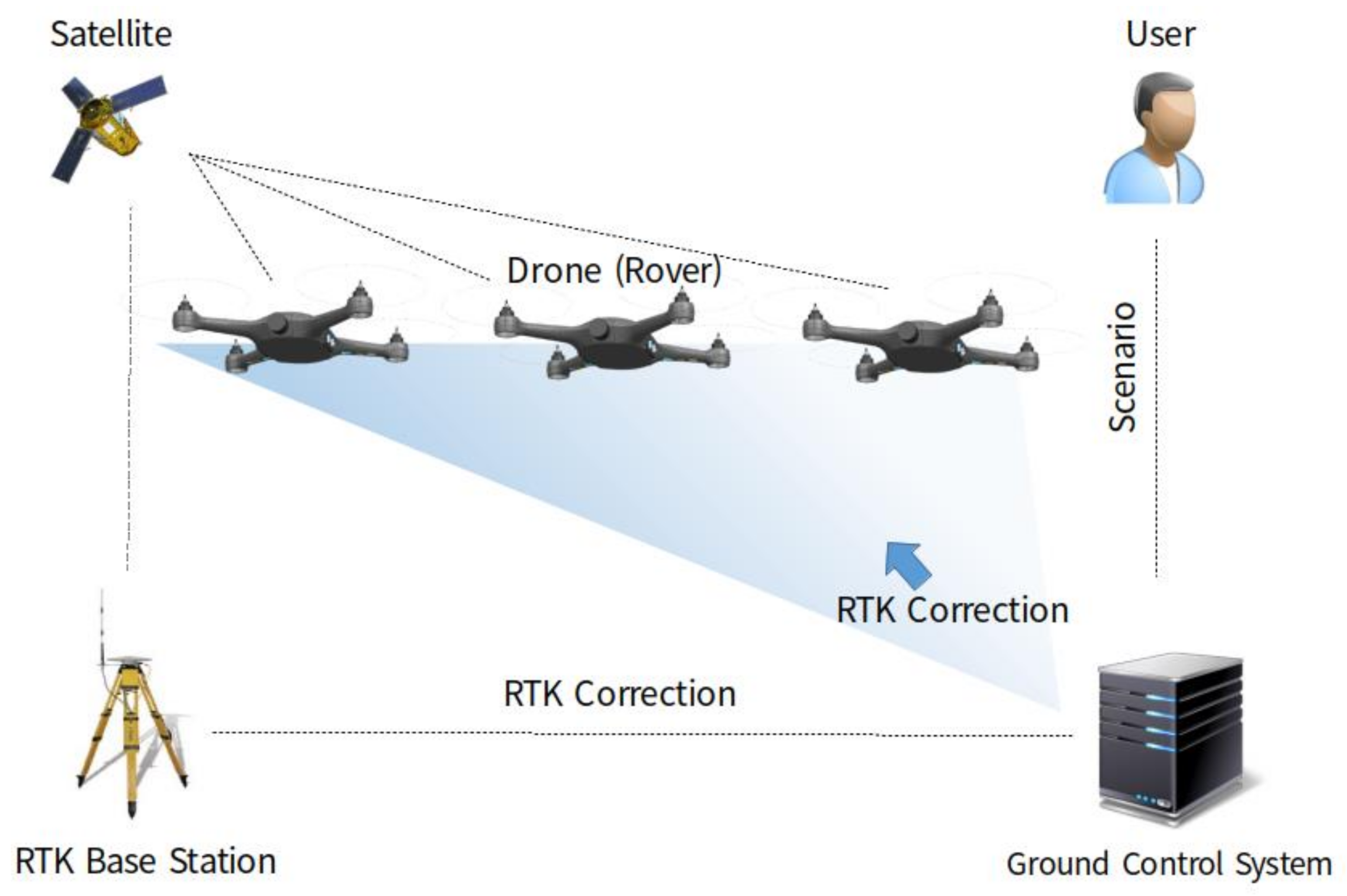

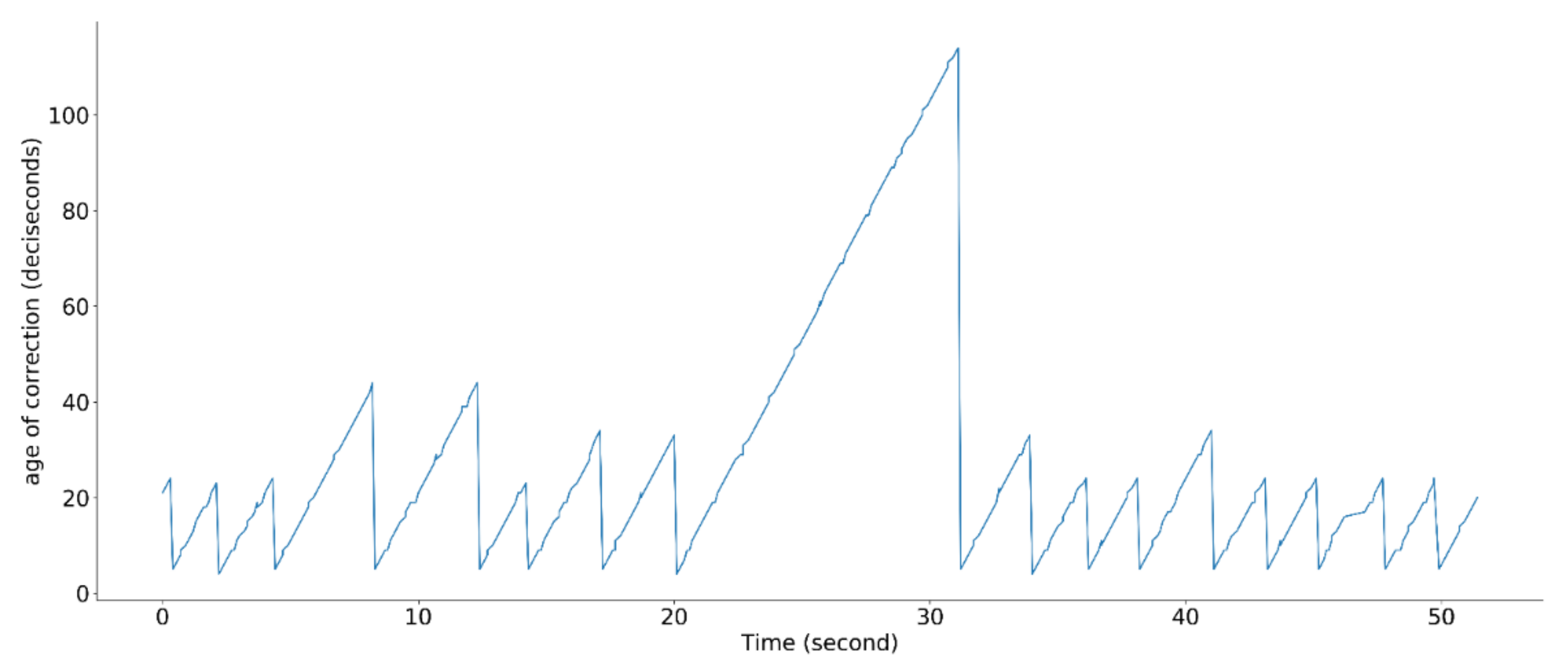




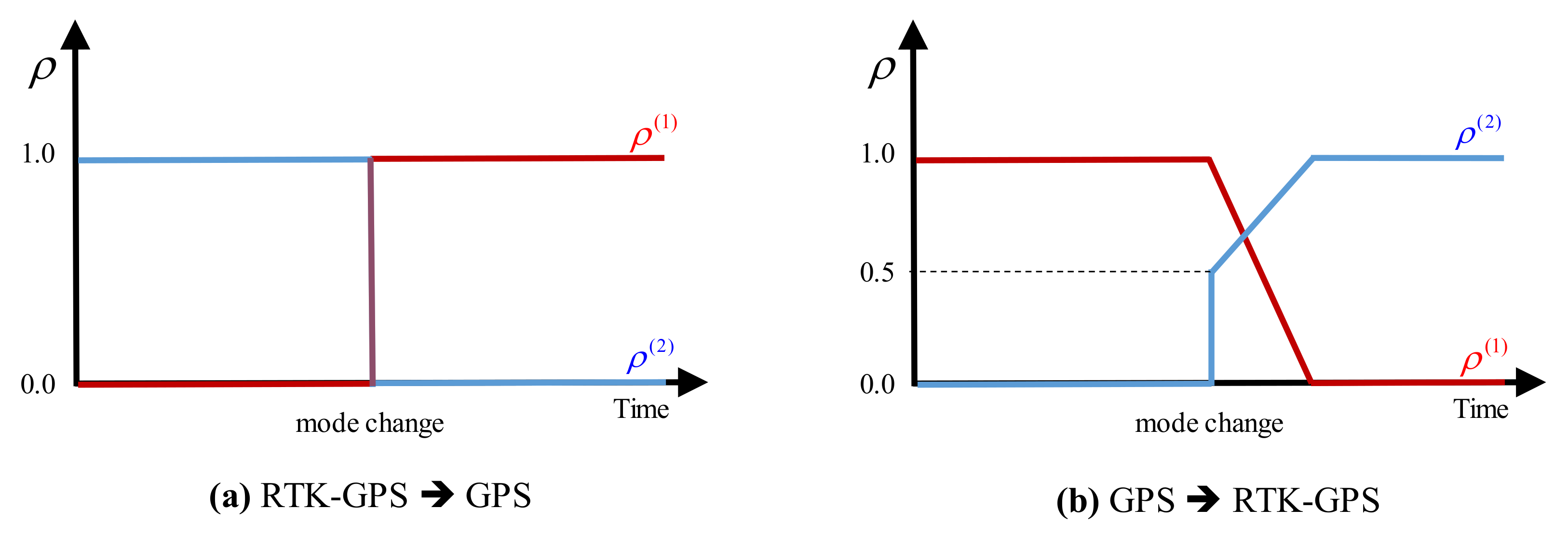



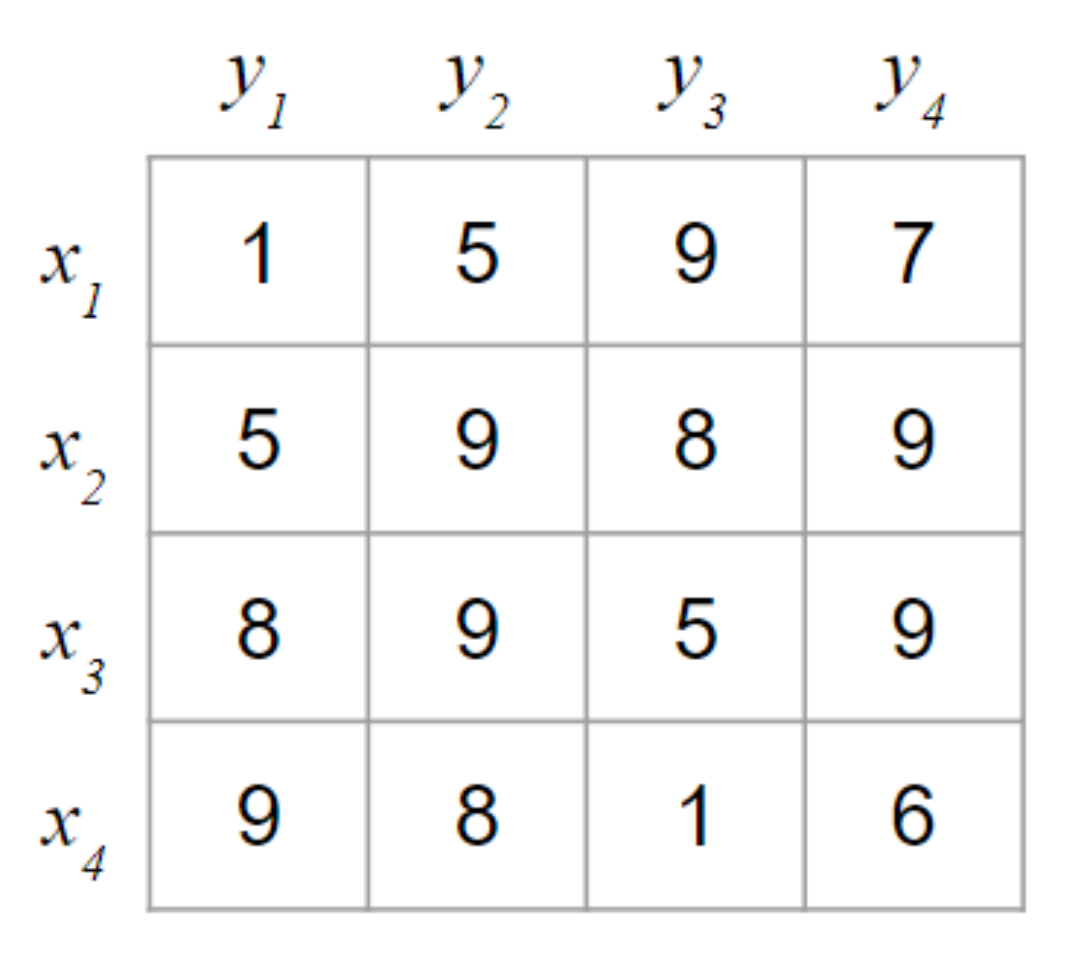

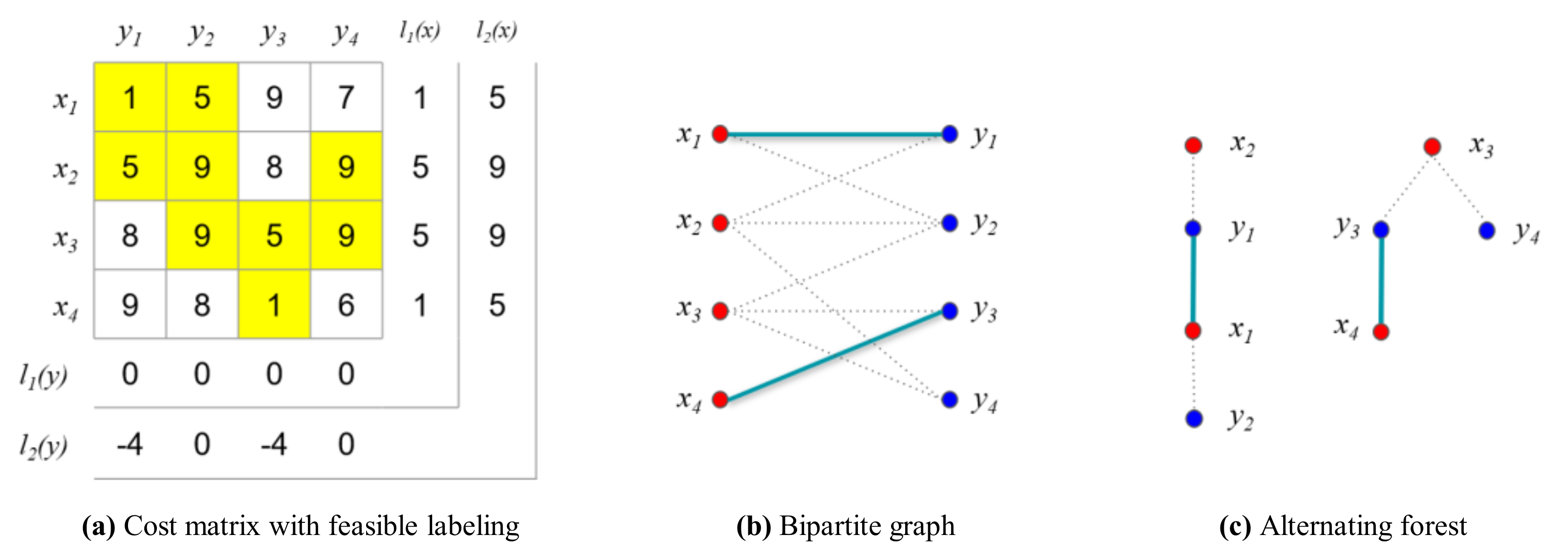
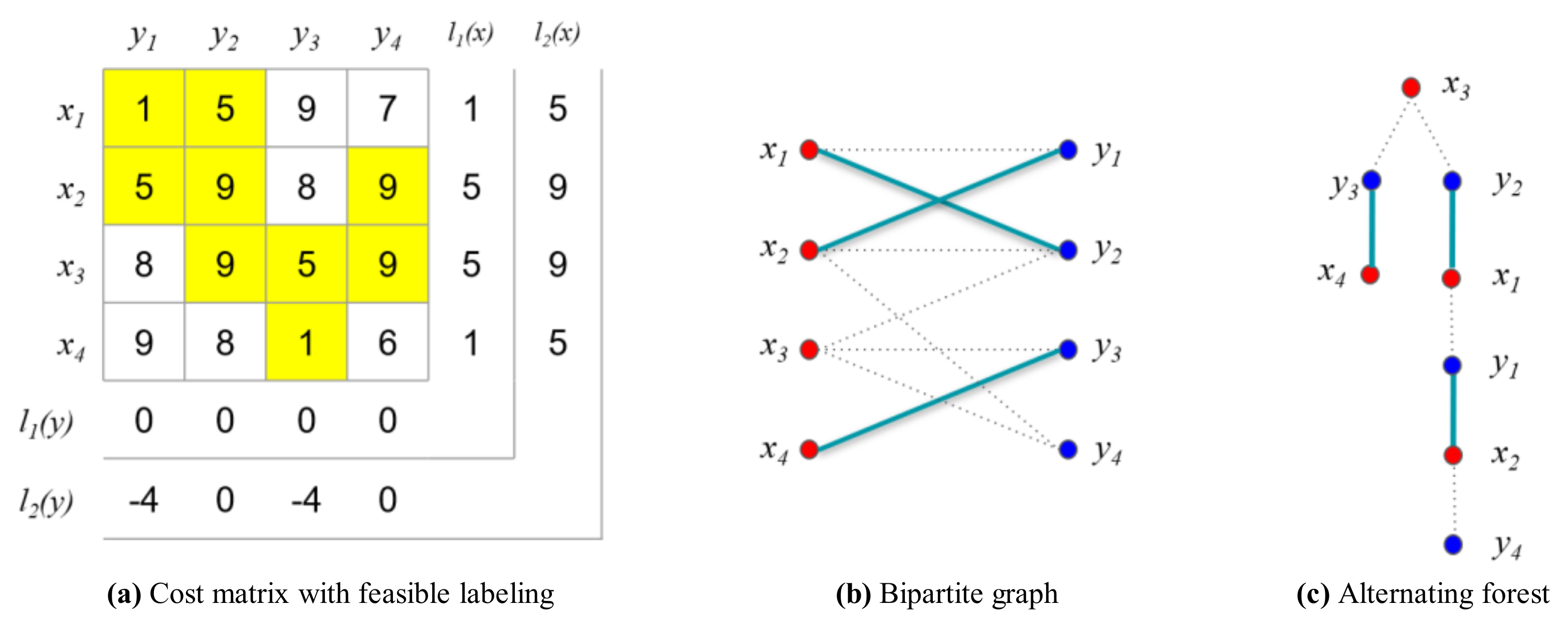
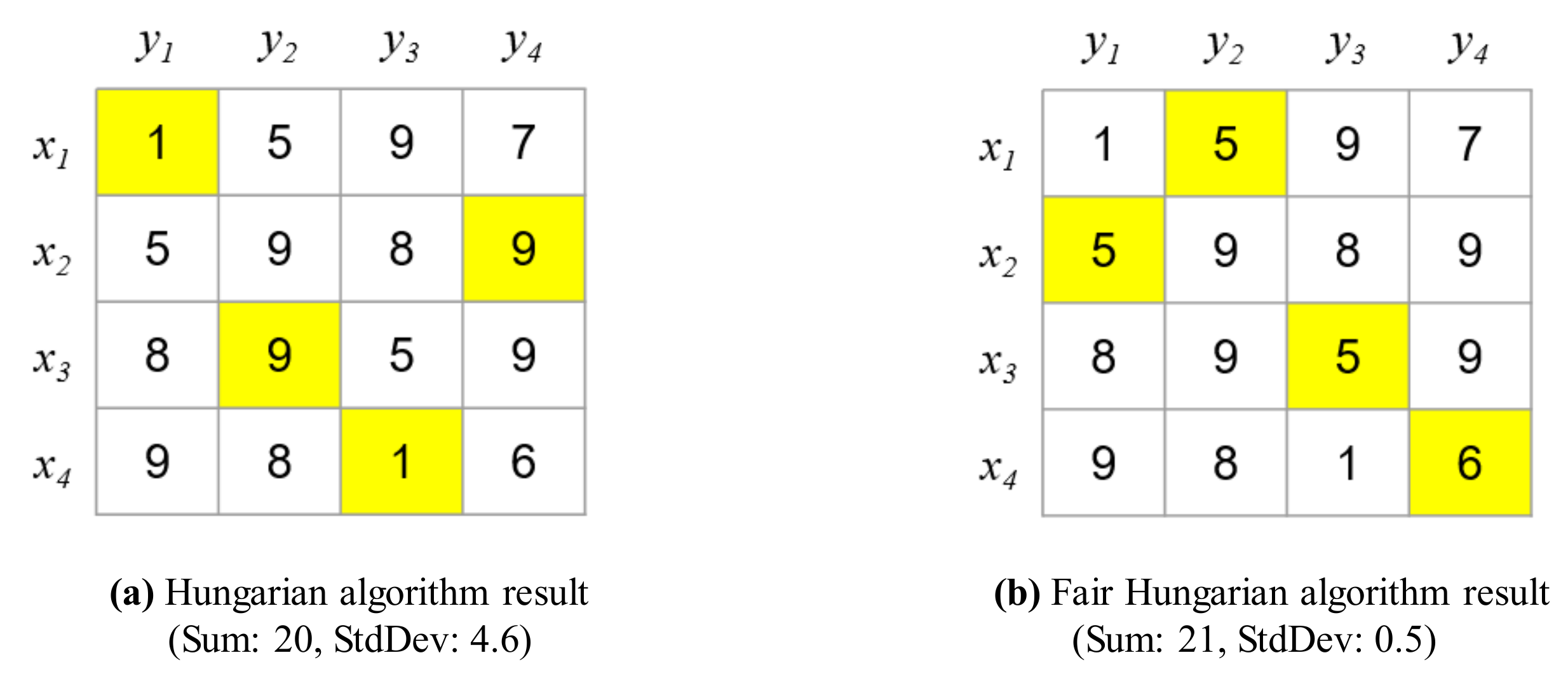


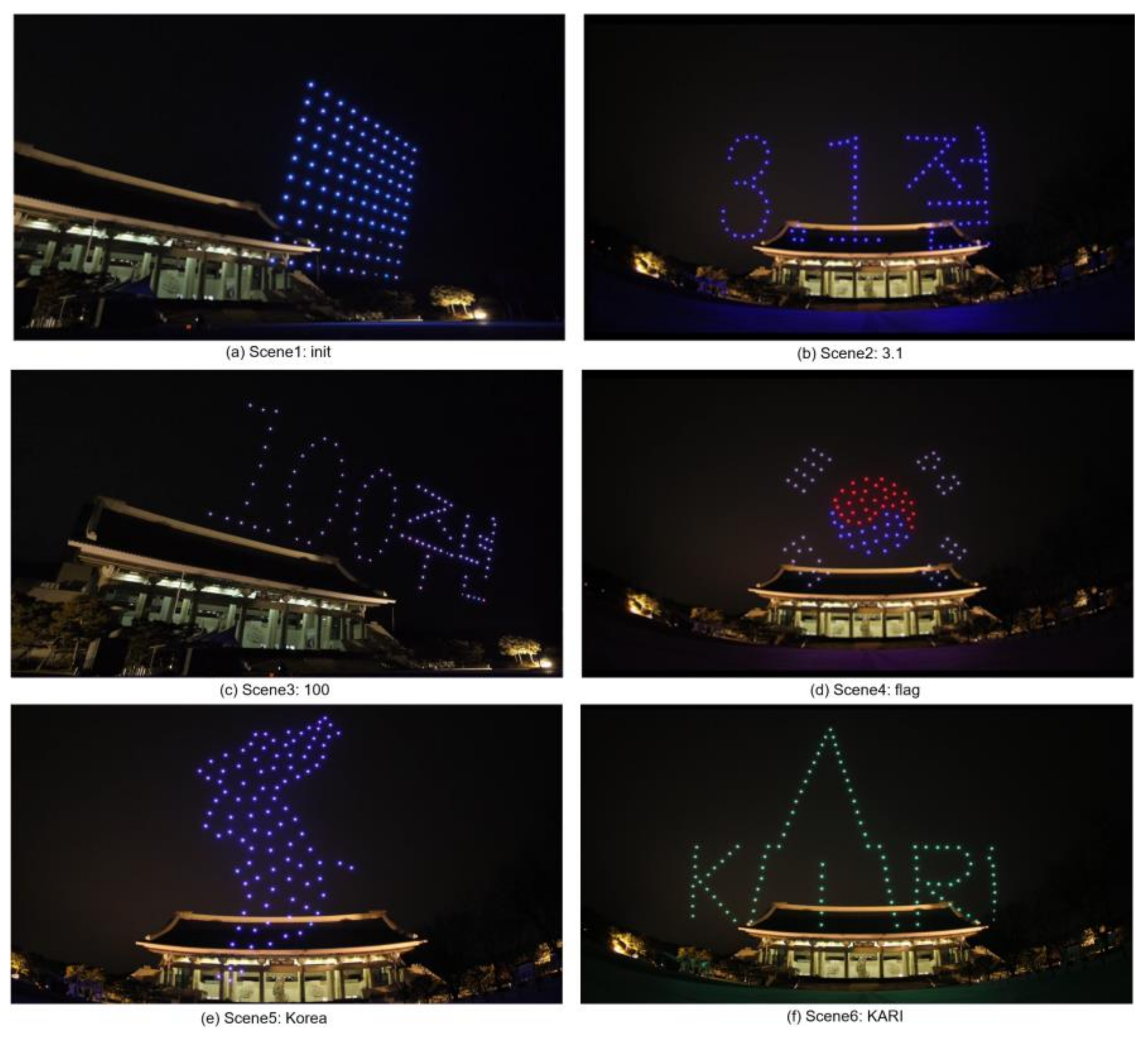

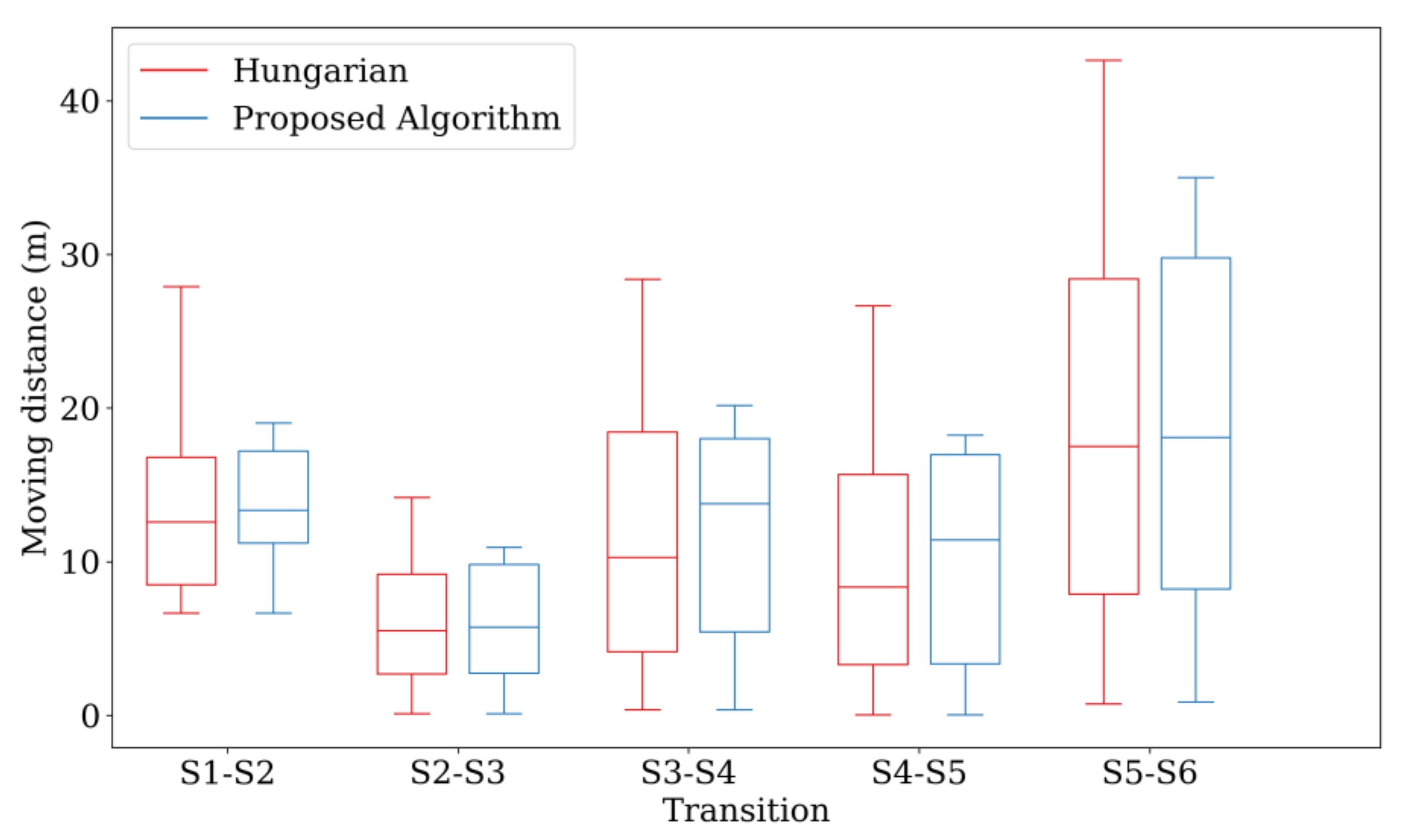

| Application | Method | Verification (# of Targets) | |||
|---|---|---|---|---|---|
| Xiangming et al. [20] | Path planning | Original Hungarian | Quality | Simulation (22) | |
| Amir et al. [21] | Drone-station matching in Smart city | Original Hungarian | Energy | Simulation (500) | |
| Smriti et al. [19] | Multi-robot orchestra | Distributed Hungarian | Distance | Demonstration (10) | |
| Sarah et al. [22] | Fast and scalable task allocation | DHBA | Distance | Simulation (50) | |
| Our works | Scene transition in Drone show | Fair Hungarian | Distance | Demonstration (100) |
Publisher’s Note: MDPI stays neutral with regard to jurisdictional claims in published maps and institutional affiliations. |
© 2021 by the authors. Licensee MDPI, Basel, Switzerland. This article is an open access article distributed under the terms and conditions of the Creative Commons Attribution (CC BY) license (http://creativecommons.org/licenses/by/4.0/).
Share and Cite
Moon, S.; Lee, D.; Lee, D.; Kim, D.; Bang, H. Energy-Efficient Swarming Flight Formation Transitions Using the Improved Fair Hungarian Algorithm. Sensors 2021, 21, 1260. https://doi.org/10.3390/s21041260
Moon S, Lee D, Lee D, Kim D, Bang H. Energy-Efficient Swarming Flight Formation Transitions Using the Improved Fair Hungarian Algorithm. Sensors. 2021; 21(4):1260. https://doi.org/10.3390/s21041260
Chicago/Turabian StyleMoon, SungTae, Donghun Lee, Dongoo Lee, Doyoon Kim, and Hyochoong Bang. 2021. "Energy-Efficient Swarming Flight Formation Transitions Using the Improved Fair Hungarian Algorithm" Sensors 21, no. 4: 1260. https://doi.org/10.3390/s21041260
APA StyleMoon, S., Lee, D., Lee, D., Kim, D., & Bang, H. (2021). Energy-Efficient Swarming Flight Formation Transitions Using the Improved Fair Hungarian Algorithm. Sensors, 21(4), 1260. https://doi.org/10.3390/s21041260






